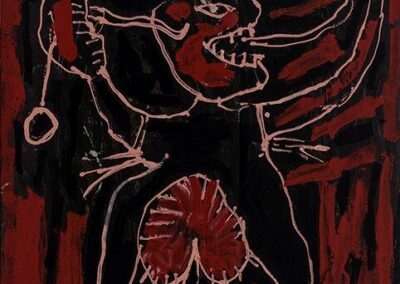Our next Artist You Need To Know was born in Israel but lived and worked in Montreal. Daniel Erban’s work is almost immediately recognizable. Art Historian James Campbell described Erban as ‘a self-taught artist who…lost many family members in the Holocaust and this deeply influenced his work, which expresses a deeply personal and even obsessive response to the whole wounded madhouse of our time.’ Campbell offers an interesting biographical ‘explanation’ for Erban’s distinct style, pointing out that Erban’s works are deeply influenced by ‘Viennese Actionism….a transgressive and violent movement of the 1960s to develop “performance art” with a singularly destructive ethos. Its principal participants were Günter Brus, Otto Mühl, Hermann Nitsch, and Rudolf Schwarzkogler.” Many of these artists, like Erban, were responding – in an emotive and expressionist manner – to the holocaust.
A graduate of Concordia University, Erban’s works are frenetic and frenzied, and the ideas that inform him are just as intense. Erban was well known in the “underground” art scene of Montreal exhibiting in spaces both mainstream and those that bridge and challenge the question of an ‘artistic’ or ‘public’ site.
-

My TV Dinner, 2002
-

Winter of our discontents, 1991
-

The Punishment Fits The Crime, 2006
-

Do Not Go Gentle Into That Good Night, 1999
-

Despair's Unhallowed Bed, 1994
Erban’s own words: ‘In the work, it is not the artist that is important but the work itself. In short, art is an activity that interacts with beauty and visual truth. I see myself as a researcher looking for notions that are visual and universally meaningful. Acting on this belief, I create strong works of art representing evil and misery in our society. This has nothing to do with my personality. What matters is the subject, that is where the artwork takes all its strength and its beauty.’
Daniel Erban died in 2017 but his biography is significant. He participated in over two hundred solo exhibitions and many international printmaking biennales. His works are included in private and public collections throughout Canada and in Europe, as well as collections from the Musée national des beaux-arts du Québec (MNBAQ), the Bibliothèque et Archives nationales du Québec / Grande Bibliothèque, the Canada Council Art Bank / Banque d’art du Conseil des arts du Canada, the Edmonton Art Gallery (now the Art Gallery of Alberta), and the University of New Brunswick.
Erban’s work has been dismissed as ‘too confrontational’, but it’s more likely that his work is so direct – and unflinching – that it unsettles the viewer because of his honesty. Although it’s been several years since his death, there is an immediacy to his scenes that speak to us today. More from Campbell, reviewing a show at Galerie Robert Poulin in 2020: Daniel Erban’s ‘work is a call for empathy. It is morally responsible work in a morally irresponsible and bankrupt world on the brink. His bold, graphic depictions of severing, hanging, vomiting, and obliterating brutality are unavoidably understood as rooted in the ineluctable condition of being here – of being, that is, in a world. His work is Socratically honest and, if it seems suffused with extreme violence, supernatural horror and the “uncanny,” it is a tribute to his indomitable nature, his refusal to compromise, to stand down. His is truly an uncompromising portrait of existential darkness.’











